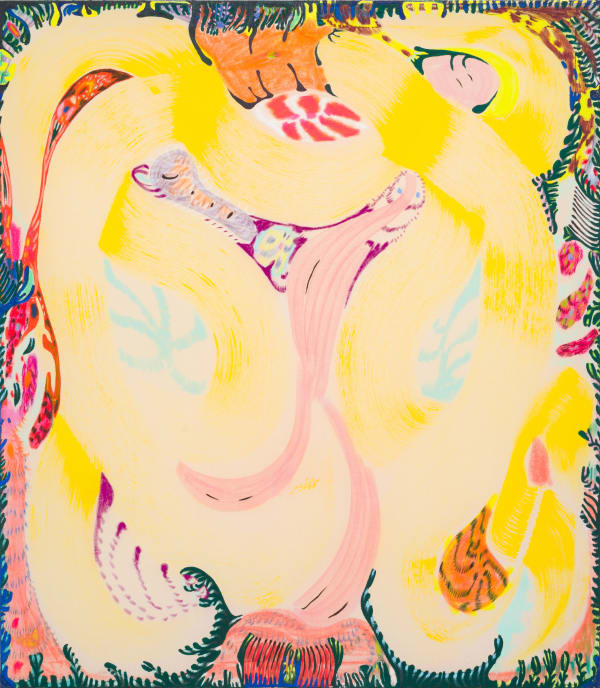-
Melania Toma
Five Hearts -

-

-
-
Employing a mixture of painting techniques using acrylic, oil, sand, pastels, ink and charcoal, Toma’s new works feature broad marks that sweep across the picture plane, mimicking the organic curvilinear shapes of tunnels made by earthworms. Alongside these loose, energetic marks, the viewer encounters wispy, playful textured areas of colour and abstract pattern that allow the viewer to imagine certain representational elements coming to life before them, such as a butterfly here or a protozoa skeleton there. In About Eggs and Soil (Hatching) (2024), for example, the broad sweeping marks take on the oval shape of an egg or an embryo, but instead of symbolising the creation of man, this depiction celebrates the capacity for all of Earth’s creatures – what Haraway calls ‘humus’ – to be reborn and live together in symbiosis to create a post-Anthropocene order of non-hierarchical collectivity.As the first Camille in five generations of Camilles in Donna Haraway’s The Camille Stories, a speculative fabulation intended to ‘propose new futures, possible futures and implausible but real nows’, Camille 1 comes into being as a symbiont of the monarch butterfly or a ‘Child of the Compost’. The monarch butterfly is a migratory species that travels every winter from the East Coast of the United States to central Mexico. In this same fashion, the first Camille adopts the old habits of hunter-gatherers and pastoralists, moving around opportunistically in the name of ecological sustenance and physical and emotional healing. Just like Camille 1 and her symbiont monarch butterfly, travel – both through time and space - feeds the artistic practice of Toma who sees this labour as an integral part of her calling to be an artist. Recent extended trips to Morocco and Uzbekistan and artist residencies in Mexico and rural France among many other places around the globe have fed the painterly vocabulary of Toma. Seeking out symbols wherever she goes, Toma recycles these shapes and forms into her work, breathing new meaning into them to create her own artistic language of transformation and collective resurgence.
-
Time travel feeds into Toma’s imagery too, having grown up in Vicenza in northern Italy surrounded by anatomical and other scientific texts in her home that stoked an interest in biology and entomology. This exhibition, in particular, travels back to a time when Toma was a young girl, providing a home and caring for a menagerie of insects and invertebrates, including crickets, grasshoppers, butterflies and earthworms. These memories alongside the monarch butterflies featured in Haraway’s The Camille Stories has inspired the colour palette of many of the works in this exhibition with an array of scarlets, oranges and yellows alongside black lines that attempt to contain the energy of the transformation of Earth’s creatures from an egg to its full glorious being. The artist equates her childhood experience of raising these critters to a metaphysical transformation of herself into a symbiont of the particular species of insect or invertebrate, akin to Camille in Haraway’s stories.Despite the five mass extinctions that have occurred over the history of life on Earth, Toma’s work looks forward to a new age that does not feature human exceptionalism writ large and the destruction caused by our capitalist-driven agricultural era. Instead, Toma privileges through her work the value and urgency of the growth and protection of other lifeforms. After all, as Timothy Morton writes in All Art is Ecological (2018), humans are not human all the way through; we are filled with millions of nonhuman bacteria and other symbionts that make us human, and we are just one being among others of equal importance in our biosphere.As Haraway attempts in The Camille Stories, Toma undertakes ‘to reshape terran life for an epoch that could follow the deadly discontinuities of the Anthopocene, Capitalocene and Plantationocene.’ Toma imagines human beings that are capable of kinship and community with Earth’s other lifeforms, like the earthworm. Although it may not have any eyes, ears, teeth or lungs, the earthworm has five pairs of heart-like organs and performs the work of an ecosystem engineer, eating organic waste in the soil while giving love to the earth with its many hearts. In this same way, Five Hearts tells a speculative story of interspecies connectivity, expressing with a paint brush both soil and soul travel from the past to the future with the artist playing the role of the nonhuman symbiont and the earthworm as her host, decomposing the artist’s flesh to organic matter to heal our ravaged planet.
-
-
Enquire
-
 Melania Toma, About Eggs and Soil (Cocoon Burial), 2024
Melania Toma, About Eggs and Soil (Cocoon Burial), 2024 -
 Melania Toma, Camilles, 2024
Melania Toma, Camilles, 2024 -
 Melania Toma, About Eggs and Soil (Hatching), 2024
Melania Toma, About Eggs and Soil (Hatching), 2024 -
 Melania Toma, Earthworm Section (About Symbionts, Birth and Dance) I, 2024
Melania Toma, Earthworm Section (About Symbionts, Birth and Dance) I, 2024
-
 Melania Toma, Deep in the Soil (Travel), 2024
Melania Toma, Deep in the Soil (Travel), 2024 -
 Melania Toma, Earthworm Section (About Symbionts, Birth and Dance) II, 2024
Melania Toma, Earthworm Section (About Symbionts, Birth and Dance) II, 2024 -
 Melania Toma, Hearts, I, 2024
Melania Toma, Hearts, I, 2024 -
 Melania Toma, Hearts, III, 2024
Melania Toma, Hearts, III, 2024
-
-
Melania Toma : Five Hearts
Past viewing_room
















